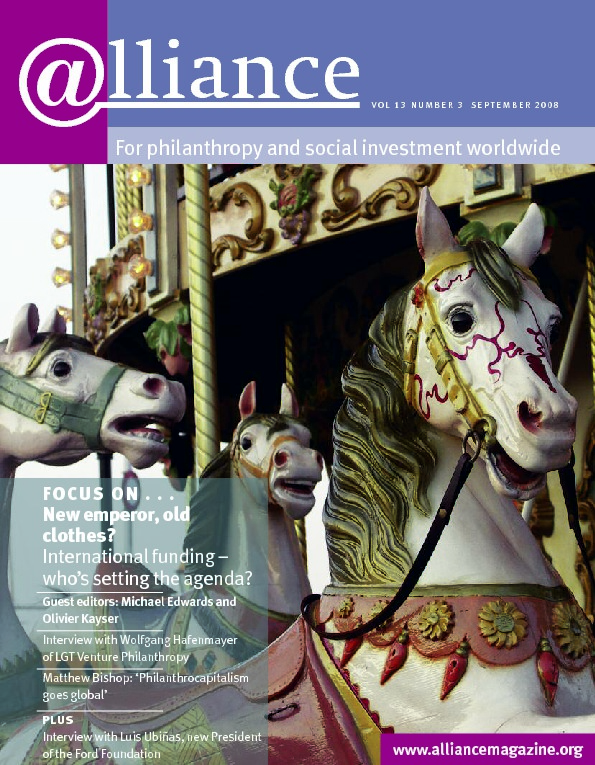 A growing supply of capital is being directed towards social investing as investors become more aware that they can have a direct impact on pressing social and environmental issues by determining the way their money is invested. This capital is coming from a variety of sources, including foundations, private banks, family offices and asset managers. But it remains to be seen if this supply of capital will continue as global equity exchanges enter bear market territory.
A growing supply of capital is being directed towards social investing as investors become more aware that they can have a direct impact on pressing social and environmental issues by determining the way their money is invested. This capital is coming from a variety of sources, including foundations, private banks, family offices and asset managers. But it remains to be seen if this supply of capital will continue as global equity exchanges enter bear market territory.
Multinational investment banks, which have traditionally eschewed the areas of microfinance and social investments, are starting to recognize the potential benefits of committing part of their resources towards developing double bottom line products. But as these investment banks contend with the fallout of the global credit crunch, a single bottom line of profits might supersede the double bottom line of financial returns and social benefit.
JPMorgan Chase is the latest bank to enter the microfinance field, having established its social sector finance group in November 2007. At the same time that JPMorgan is scaling up its work in this field, Morgan Stanley is scaling back the work of its microfinance unit, formally established less than a year ago, in September 2007.
JPMorgan’s social sector finance group is part of the bank’s increased focus on microfinance as part of its social responsibility agenda. The group plans to use the bank’s resources to develop microfinance institutions and bring financial services to social enterprises around the world. The work will include capital markets, structured products and principal investments. The bank estimates that overall capital need for sustainable financial services among low-income groups in the developing world is $300 billion.
Christina Leijonhufvud, responsible for the unit’s daily operations, said the bank has $50 million for direct equity investing in microfinance and related sectors that serve the base of the economic pyramid, as well as using JPMorgan’s credit capacity to loan to companies. ‘Ultimately, we’re looking for well-run businesses that serve the base of the pyramid,’ she said.
JPMorgan employees, from senior management down, have been enthusiastic about the new unit and have volunteered their services. The bank has also been asked about its work in the microfinance field during recruitment drives, which is strengthening the unit’s appeal. ‘In a Wall Street environment, to be confronted by all of these bankers who say they want to help and want to do it for free is a pretty amazing experience,’ Leijonhufvud said.
But the unit is not completely insulated from problems in the global markets. Leijonhufvud noted that they have put plans on hold to offer a debt fund because of the crisis in the credit markets. ‘It’s naive to think that people will maintain their appetite for these products in the current environment,’ she added.
But as JPMorgan looks for new opportunities in the microfinance and social investment fields, Morgan Stanley has scaled back its plans for the sector. The Morgan Stanley Microfinance Institutions Group was reorganized in June 2008, less than a year after it was established in September 2007, when it boasted that it was ‘the first time that an investment bank has established a group dedicated to serving microfinance institutions’.
The unit’s reorganization came just weeks after Morgan Stanley had won the sustainable deal of the year award with BlueOrchard Finance of Switzerland, awarded by the Financial Times and the International Finance Corporation. Morgan Stanley and BlueOrchard were named for their collateralized loan obligation, called BOLD 2, which raised $110.2 million for 20 institutions in 12 countries. Standard & Poor’s rated the transaction, the first time a capital markets microfinance transaction had been rated by a major rating agency.
The unit may have been a casualty of the bank’s struggle with the tight credit market worldwide. In June, a few weeks before the unit’s reorganization, the bank reported a 58 per cent fall in net profits in its second quarter.
According to a statement from Morgan Stanley, the bank ‘remains committed to microfinance and continues to pursue opportunities in this space. We are constantly evaluating business conditions to ensure we are right-sized for the current market environment and we continue to utilize employees across the firm for this initiative.’
Investors’ perspectives is produced in collaboration with Investing for Good, a social finance intermediary and asset manager founded in 2004. http://www.investingforgood.co.uk
Geoff Burnand, Chief Executive of Investing for Good, is author of the first Investors’ Perspectives column. Email gburnand@investingforgood.co.uk






Comments (0)